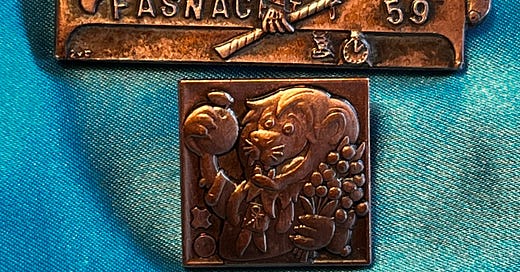Fasnacht: The Art of Protest
“A wit once quipped that picking their nose was the closest some people came to penetrating the mysteries of the mind; the people of Basel, in contrast, cultivate Fasnacht...(Peter F. Kopp, historian)
At 4 AM on Monday, March 10, a fantastic 72-hour festival will begin in the city of Basel — 12 km from the town of Dornach where I lived with my Swiss family in 1959.
"When the clock strikes four on Monday and all the city lights go out, that is when the enjoyment begins, made all the more poignant because everyone knows that this masquerade is of cruelly short duration. Then comes the moment when the drum major gives the command ‘Ach — tung! Dr Morgestraich - vorwärts, marsch!’ Although it is the first march, it is played on-the-spot, but in formation. Only after this overture does movement start as each Clique embarks on its own route in the early morning darkness, illuminated by nothing more than its processional lantern and smaller head-mounted and hand-held lanterns." [from an exhibition handout from the Museum der Kulturen Basel]
The larger of the two copper badges shown above is one of my treasured mementos from Switzerland. Introduced in 1911, these “Plaketten” (or “Blaggedden,” in Basel dialect) sport a new design each year, and are sold as tickets to the 3-day celebration. Proceeds from sales go towards the expenses of the festival, and include subsidizing the officially registered groups or 'Cliques' whose members march in the Monday and Wednesday parades. I ordered the smaller pin online for 2025, and was surprised to find it to be less than half the size of the old one.
In 1959, when I was 11 and got to attend this festival with my Swiss family, the celebration felt like pure fantasy — and it still conjures up dreamy visions of color, music, and festivity in my memory. The Cliques streamed by in a boisterous and festive parade, one group after another of masked, costumed drummers and piccolo players marching in formation to the beat of their drum major, who wore an oversized mask covering the entire head. Huge wagons with floats on them rolled down the street carrying brightly-lit lanterns — stunning artistic creations inscribed with slogans or rhymed verse. Now and then the spectators lining the street were showered with confetti, candy, and oranges, tossed down by the costumed characters riding on the floats. Along with every other child, I tried to catch the falling goodies midair, then dove down to grab as many as possible when they hit the ground. I also managed to snap a few pictures with my little camera, few of which came out very well.
Back then, swept up in pure delight, I was totally unaware of the role Fasnacht fulfills as a forum for creative social commentary and political protest. Now, I’ve been reading a bit over the past few weeks to discover the history and impetus behind this festival.
Fasnacht has been celebrated for centuries, evolving along the way. The earliest documented records of Basel Fasnacht are from the 1300’s. In the early 15th century there were bans on the use of drums and pipes during the festival, possibly due to the association with ‘lewd and abandoned dancing.’ Other changes occurred between that time and the establishment of the Swiss Federation in 1848, when political topics started to be increasingly targeted for criticism.
According to the Museum der Kulturen Basel, “the people of Basel are known far and wide for their ‘esprit moqueur’, a predilection for ridicule that hits peak form during the carnival period.” Foreign heads of state, the papacy, and controversial social themes like censorship, LGBTQ, racial and economic inequity are all open to being targeted for criticism in the form of artworks, costume, songs, and verse.
The Tinguely Museum in Basel held a special exhibit in 2013, all about Fasnacht. In it they explained the Kuttelbutzer, a group of satirical singers who perform at the festival: “The Kuttlebutzer originally developed out of an eponymous “Schnitzelbangg” (group that sings satirical songs in Basel hostelries at Carnival time), which regularly caused scandals in the later 1940s and 1950s with its controversial texts and originally designed “Zeedeln” (pamphlets bearing ironic verses). The singers subsequently maintained their satirical spirit in the clique, which immediately attracted attention with its feisty critical statements.”
The Cliques are groups of festival participants who make plans throughout the year for their contribution to the coming Fasnacht. The lantern is the pride and joy of each Clique, and one of their key contributions to the festival. Each Clique chooses what subject to feature on their lantern for that year. The members of these groups usually form tight bonds, and often get together during the year for other informal social activities as well.
The lanterns were originally flaming torches carried by participants, until they were banned in 1845. Today the lanterns have evolved to huge and elaborate panels made of canvas, adorned with elaborate artwork and rhyming couplets in the local Basel dialect, which address the chosen topic. These verses are also printed on slips of paper (Zeedel) for revelers to take with them, and often read aloud as proclamations by a spokesperson from the particular float. By nightfall, the ground is littered with multicolored confetti and equally colorful verses.
These lanterns are elaborate works of art. “Not every lantern is created in the same way. Once the design has been perfected on the basis of a succession of sketches, it is transferred to a canvas that has been stretched over a frame and treated with an undercoat. Some artists do this freehand, some are guided by a faint grid, yet others use digital imaging and plotters. A wide variety of paints are used; the only criterion being that light must be able to pass through them: coloured Indian inks, stains, watercolours, aniline, oil or fabric paints. Once the outside has been completed, any parts which fail to stand out sufficiently are painted on the inside too; this is called ‘back painting’. Finally, the verses and epigrams are added — not forgetting the all-important witticisms on the door which provides access to the internal lights. Generally speaking, once the lantern is ready, Morgenstreich cannot be far away!” [from the Museum der Kulturen Basel exhibit handout]
When I searched for specific information about Fasnacht 1959, when I attended, I was unable to find any references to the Cliques seen in my own photos. But I did learn that a central theme that year was the censorship of a new anti-war film, banned in Switzerland until 1970 on the grounds that it was “incontestably offensive” to France, its judicial system, and its army:
“In 1959 the title of the formation was “Kuttlebutzer auf dem Wege zum Ruhm” (“Kuttlebutzer on the Path to Fame”), which was a critical protest against the censoring of a Stanley Kubrick film [Paths of Glory] by the Swiss federal government (under pressure from France, after the French army had taken offence at the film having shown it in a bad light). The Kuttlebutzer’s attitude of protest in defense of freedom of expression and artistic creativity became part of their general agenda and often influenced them in their choice of subjects.” [from the Tinguely Museum 2013 exhibit mentioned above]”
In 2017, the current US president was featured on at least one Fasnacht lantern. On a side panel, the vertical word ‘PRIMAT’ (‘primate’) intersects with his last name.
Also in 2017, Fasnacht was inscribed on UNESCO’s Representative List of the Intangible Cultural Heritage of Humanity. “Beginning on the Monday following Ash Wednesday and lasting exactly 72 hours, Basel Carnival is the largest carnival in Switzerland. Two parades take place on the Monday and Wednesday, bringing together 11,000 costumed carnivalists in parades of fife and drum cliques, floats and carriages. Tuesday is dedicated to children, with concerts and lantern exhibitions, while other events also punctuate the festival. The carnival can be compared to a huge satirical magazine where all visual or rhetorical means are used to make fun of flaws and blunders. Around 20,000 people of any age, social status, origin and political persuasion actively participate in the festival, which attracts around 200,000 Swiss and foreign visitors. The bearers and practitioners form associations of different types, composed equally of men and women. The carnival contributes to social cohesion, promotes tolerance through social criticism and helps safeguard the local dialect.”
MORE INFORMATION:
The Museum der Kulturen Basel offers a permanent exhibition about Fasnacht. On this site you will find a PDF of their Fasnacht handout, with a ton of historical information. The PDF can be downloaded by clicking on “exhibition texts” on the right, under DOWNLOAD.
Change & Continuity at Basel’s Fasnacht HKB Bern Academy of the Arts, Institute Materiality in Arts and Culture sponsored by the Swiss National Science Foundation, posits that “Ephemeral and reliant on the body as medium, performance-based artworks challenge the assumption that a work of art can be fixed, static and ‘conservable’ – an object easily constrained by established systems of documentation and archival ordering. Further, traditional conservation too often disregards the intangible aspects of heritage conveyance that are necessary to preserve performance: the transmission of memory, skill, technique, and tacit knowledge.”
Finally, if you want to see a hilarious 2-minute skit in a well-delivered mash-up of German and English that shows audience reactions and costumes, look for this on Youtube — you needn’t know German to understand the satire:









Fassenachting!
I am amazed that you even took pictures back in 1959. I love the "Blaggedden." Amazing too that you kept yours all these years. The 1959 one is definitely better than the 2025 edition.
Wonderful post, full of information and links!
I love this idea, but it's hard to mock someone who is himself a mockery... Would love to know how.